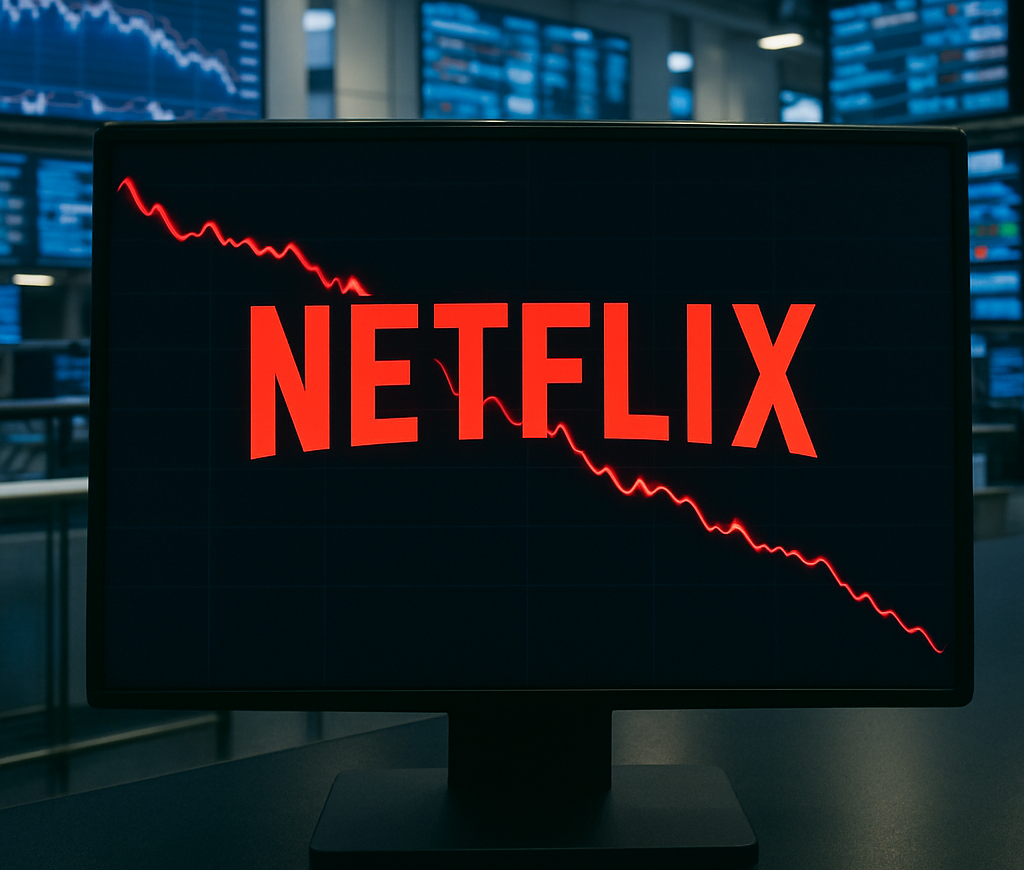Netflix, the global streaming giant, faced a sharp market reaction after its recent revenue forecast left Wall Street investors unimpressed. On July 19, 2025, shares of the company plunged over 4%, reflecting growing unease about Netflix’s ability to sustain its pace of revenue growth as competition intensifies and consumer spending becomes increasingly selective.
Background: A Streaming Titan in Transition
Since its transformation from a DVD-by-mail business to a streaming powerhouse, Netflix has consistently set the direction for the global entertainment industry. Over the past decade, the company has amassed more than 250 million subscribers worldwide and spent billions on original content, from Oscar-winning films to hit television series. This aggressive content strategy has paid off in terms of market share and global cultural impact.
However, the landscape has evolved rapidly in recent years. Rivals such as Disney+, Amazon Prime Video, Apple TV+, and local streaming platforms have entered the fray, fragmenting consumer attention and increasing the competition for content rights and top-tier talent. Meanwhile, macroeconomic headwinds—including inflation and shifting household budgets—have made subscribers more value-conscious and, in some cases, more willing to cancel or switch streaming services.
The Revenue Miss: What Happened?
Netflix’s latest earnings call, eagerly anticipated by investors and analysts, featured not only a review of its recent quarterly performance but also forward-looking guidance that proved disappointing. Despite strong subscriber growth and a marginal lift in advertising revenue from its ad-supported tier, Netflix predicted modest revenue expansion for the coming quarter—below the levels analysts had been expecting.
Key points include:
- Subscriber growth remained solid, especially in non-U.S. markets, fueled by strategic pricing and local-language content.
- Revenue growth, however, lagged expectations despite the increase in absolute subscriber counts. Management cited slower-than-expected gains in average revenue per user (ARPU), particularly in mature markets where competition is stiffest.
- Ad-supported tier uptake was lower than anticipated, revealing continued ambivalence among users toward streaming ads, even those offered at lower price points.
- Content costs remain elevated, as Netflix must outspend rivals to secure high-profile series and films to keep its library attractive and up-to-date.
Investor Reaction: Why the Drop Was So Severe
The over 4% decline in Netflix’s share price is notably sharper than typical post-earnings fluctuations for the company in recent quarters. Analysts say the market’s reaction stems from two primary concerns:
Revenue Per User Is Flattening: While Netflix’s subscriber base is still growing globally, average revenue per user is under pressure from pricing strategies tailored to emerging markets and softer performance in the U.S. and Europe. Investors worry that Netflix’s room to maneuver on pricing without risking churn is narrowing.
Ad-Supported Model Underwhelms: Netflix’s much-touted pivot to advertising, aimed at unlocking new revenue streams, is progressing more slowly than hoped. Advertisers may be hesitant to redirect budgets from established video platforms, and consumers are showing only limited willingness to embrace ads—even at a discount.
Market and Competitive Pressures
Beyond the immediate numbers, the broader environment for streaming is becoming less forgiving. With content costs rising and licensing battles fierce, Netflix must balance innovation with profitability. Competitors are experimenting with similar ad-supported offerings and investing heavily in original and live content. Some, like Disney+, leverage their legacy libraries and affiliated franchises as a competitive advantage. Others, like Amazon, integrate streaming into broader e-commerce and technology ecosystems.
Moreover, some investor discontent centers on saturation in key markets. In the U.S. and Western Europe, many households already subscribe to multiple streaming platforms. Growth, therefore, relies increasingly on less lucrative regions or on converting password-sharing households into paying customers—past initiatives in this direction have had mixed results.
Future Outlook: Challenges and Opportunities
Despite the negative market reaction, Netflix remains a formidable player with several promising levers at its disposal:
- International Expansion: Continued localization and investment in non-English content have given Netflix inroads into vast, underserved markets.
- Interactive and Live Content: Ventures into live programming, sports, and interactive storytelling represent new growth frontiers.
- Technology and Monetization: Upgrades to recommendation algorithms, improvements in mobile streaming, and data-driven personalization may reinforce user engagement and retention.
Ultimately, Netflix’s recent share price dip illustrates the market’s high expectations—and the inherent volatility—of the streaming industry. While a single disappointing forecast does not spell doom for the company, it underscores the critical need for sustained innovation, execution, and adaptation in an ever-changing digital entertainment landscape.

